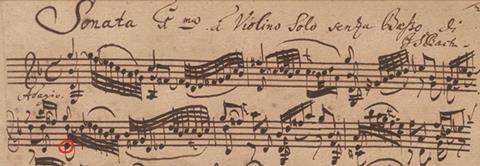A selection of letters The Strad receives each month from its readers around the world: October 2019 issue

The first page of Bach’s BWV1001 manuscript with the disputed ‘E’ circled in red
ACCIDENTAL DEATH
I respectfully disagree with Hagai Shaham’s studious claim that there is a flat symbol ‘missing’ from the note E in the third bar of Bach’s 1720 manuscript copy of his Solo Violin Sonata no.1 in G minor BWV1001 (The Strad website bit.ly/2Z8qEhq). Conversely, I believe that the ‘reminder’ accidental in the following bars shows that the composer was fully cognisant of the change there from natural to flat. Composers do not always make the same statement in the same way twice. Life would be pretty boring if they did. I also enjoy hearing different musicians interpret the same music in different ways and I think we will just have to live with the fact that some will play this note as an E natural and others will play it as an E flat.
The same ‘mistake’ occurs in the opening of the Fuga, too. In these instances the E natural sets up a tonal conflict that continues throughout the movement, both of which include examples of harmonic sequences that rely on the resolution of a raised or lowered pitch. I would also argue that the clearly marked E flat in the parallel passage at bar 14 of the Adagio should be read as emphasising the contrast between the two statements, not as proof that an E flat was intended in the first instance. Bach’s notation of accidentals is clear elsewhere, as in passages of fast-moving harmony on the second page of the Fuga.
As modern musicians performing on modern instruments with modern bows, we may still wish to bring elements of authenticity into performances, breathing life into the actual notes the composers left us. Since they can no longer speak for themselves, we are left to interpret their clues using our best guess – and no matter how hard a composer tries to clarify their intentions they will always leave behind some degree of interpretative ambiguity!
HARRIS SHILAKOWSKY
Boston, MA, US
SPLITTING HAIRS
From reading Audrey Morse’s letter regarding bow horsehair and hide glue (Soundpost, August 2019) it is quite apparent that she is under several misconceptions regarding the sourcing of horsehair and hide glue. Horses are not killed to provide those two items. Rather the two items are by-products of the slaughter of horses for human food in countries, several of them in Europe, where horse meat is as common in food markets as beef and pork are in the US and the UK. I have great respect for Ms Morse’s feelings and opinions, but those are the facts.
The lutherie trade purchases a minuscule portion of the amount of hair generated, and the rest is simply burned, contributing additional carbon dioxide to the atmosphere. The animals killed will continue to be killed, whether we play on real bow hair and use hide glue to hold our instruments together, or if we utilise some other arcane substitute yet to be developed.
CLETE DAVIS
Elmhurst, IL, US
Of course horsehair ‘is the product of the slaughterhouse’ but the horses have, by then, reached the end of their natural lives: the price of a tail is much less than that of a healthy horse. The world today is, quite rightly, turning against plastics - where is your discarded plastic bow hair going to go? Probably to landfill, where the fibres will remain intact for many human lifetimes. I have tried using nylon hairs and in my opinion they are no substitute for horsehair in a professional player’s bow. Horsehair is an amazing and currently inimitable material that must be treasured.
Some years ago another letter printed in The Strad asked if it were possible to make a vegan violin. The best answer, though terse, came a couple of months later: ‘No.’ I couldn’t agree more. Leave the poor instrument, its bow and its terrifically far-sighted inventors alone. By all means create a new instrument, but be very careful what you wish for. Finally, make your bow rehair last. Don’t overdo the rosin and keep the bow hair and instrument strings as clean as you can. Assuming quality materials, a good rehairing should last years: if it doesn’t, the culprit is you, not the hair.
ANDREW BELLIS
Bournemouth, UK






















![[letter 2] Myra Ross pc David Seth Ross](https://dnan0fzjxntrj.cloudfront.net/Pictures/100x67/1/4/5/30145_letter2myrarosspcdavidsethross_111020.jpg)
![[letter 4] Just-Dragonetti-bass](https://dnan0fzjxntrj.cloudfront.net/Pictures/100x67/6/6/7/29667_letter4justdragonettibass_69173.jpg)







No comments yet